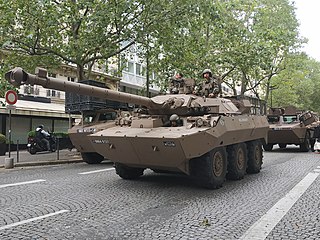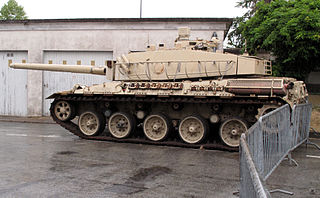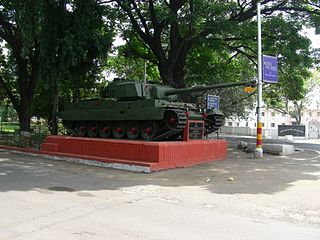Related Research Articles

The FV4034 Challenger 2 is a third generation British main battle tank (MBT) in service with the armies of the United Kingdom and Oman. It was designed and built by the British company Vickers Defence Systems, now known as BAE Systems Land & Armaments.

The Centurion was the primary British Army main battle tank of the post-World War II period. Introduced in 1945, it is widely considered to be one of the most successful post-war tank designs, remaining in production into the 1960s, and seeing combat into the 1980s. The chassis was adapted for several other roles, and these variants have remained in service. It was a very popular tank with good armour, manoeuvrability, and armament.

The Type 59 main battle tank is a Chinese-produced version of the Soviet T-54A tank, an early model of the ubiquitous T-54/55 series. The first vehicles were produced in 1958 and it was accepted into service in 1959, with serial production beginning in 1963. Over 10,000 of the tanks were produced by the time production ended in 1985 with approximately 5,500 serving with the Chinese armed forces. The tank formed the backbone of the Chinese People's Liberation Army armoured units until the early 2000s, with an estimated 5,000 of the later Type 59-I and Type 59-II variants in service in 2002.

The FV4030/4 Challenger 1 is a British main battle tank (MBT) used by the British Army from 1983 to 2001, when it was superseded by the Challenger 2. It is also currently used by the Royal Jordanian Army as its main battle tank, after substantial modifications. The variants for the Jordanian military were planned to be upgraded using an unmanned turret called the Falcon, which was developed locally but the status of this project remains unclear.

The FV4201 Chieftain was the main battle tank of the United Kingdom during the 1960s–1990s.

The FV 214 Conqueror, also known as "Tank, Heavy No. 1, 120 mm Gun, Conqueror" was a British heavy tank of the post-World War II era. It was developed as a response to the Soviet IS-3 heavy tank. The Conqueror's main armament, an L1 120 mm gun, was larger than the 20-pounder (83.4 mm) gun carried by its peer, the Centurion. The Conqueror's role was to provide long range anti-tank support for the Centurion. Nine Conquerors were issued for each regiment in Germany, usually grouped in three tank troops. In the British Army both the Conqueror and the Centurion were replaced by the Chieftain.

The AMX-10 RC is a French armoured fighting vehicle manufactured by Nexter Systems for armoured reconnaissance purposes. Equipping French cavalry units since 1981, over 240 remained in service with the French Army in 2021. 108 units were sold to Morocco and 12 to Qatar. "RC" stands for "Roues-Canon", meaning "wheeled gun". The vehicle can be described as a wheeled tank destroyer or light tank, being referred to as a "char", which is the French word for tank, in French service.

The AMX-10P is a French amphibious infantry fighting vehicle. It was developed after 1965 to replace the AMX-VCI in service with the mechanized regiments of the French Army. The first prototypes were completed in 1968. Production commenced between 1972 and 1973.

The AMX-32 was a French main battle tank developed by AMX and APX in the late 1970s during the Cold War as an export tank to fit in a specific market niche of nations with smaller defence budgets. While six prototypes were built, it failed to garner interest for foreign sales.

The SK-105 Kürassier is an Austrian light tank armed with a rifled 105 mm gun in an oscillating turret. It is estimated that over 700 have been produced.

The Vickers MBT is a series of main battle tanks (MBTs) developed as a private venture by British company Vickers-Armstrongs for export. The design makes use of proven components, such as the L7 gun of the Centurion, the Leyland L60 multi-fuel engine, the transmission and fire control system of the Chieftain. Many copied tanks were also built by India under licence as the Vijayanta.

The Type 80 and the Type 88 are a family of Chinese second-generation main battle tanks (MBTs). They are also known as the ZTZ80 and ZTZ88.

The AMX-40 was a French main battle tank developed by GIAT during the latter stages of the Cold War as an export tank to replace the earlier AMX-32. Designed to be an inexpensive tank orientated towards militaries with smaller defence budgets, the AMX-40 featured a lightly armoured hull and good mobility reminiscent of previous French MBTs with a powerful 120 mm cannon. It however failed to attract interest and sales, rendering the project a failure, being discontinued in 1990.

The Vijayanta was a main battle tank built in India based on a licensed design of the Vickers Mk.1. The Vijayanta was the first indigenous tank of the Indian Army.

The AMX-30 AuF1 is a French self-propelled gun vehicle currently in use by the armies of France and Saudi Arabia. It replaced the former Mk F3 155mm in French Army service. The AuF1 primary advance is that it incorporates full armor and nuclear-biological-chemical (NBC) protection for its crew of four, while the former Mk F3 155mm offered no protection and could carry only two of its four crew members. The AuF1 saw combat with the Iraqi Army in the Iran–Iraq War.

The 155 mm self-propelled gun Mk F3, or the Canon de 155 mm Mle F3 Automoteur (Cn-155-F3-Am), was developed in the early 1950s by the French Army to replace their American M41 Gorilla 155mm self-propelled guns. The Mk F3 is the smallest and lightest 155 mm motorized gun carriage ever produced, and because of its size and low cost it has found considerable success on the export market. Constructed on a modified AMX-13 light tank chassis, the Mk F3 is novel in incorporating room inside for only two of the eight required crewmen. This allows the 155 mm gun to be placed on a smaller chassis than that employed by other armies, but exposes the outside crew members to enemy fire and other hazards.

The OF-40 is an Italian main battle tank developed as a joint venture between OTO Melara and Fiat, and intended primarily for export sales. OTO Melara would develop and produce the hulls, and automotive components would be provided by Fiat. Initial design work was started by OTO Melara in 1977, with the first prototypes ready by 1980.
The post–Cold War era is the period in world history from the collapse of the Soviet Union on December 27, 1991 to the present. During the Cold War, the Soviet domination of the Warsaw Pact led to effective standardization on a few tank designs. In comparison, France, Germany, the United States, and the United Kingdom had previously developed their own tank designs, but now tried to standardize their designs, while the smaller nations of NATO purchased or adapted these designs.

The FV4601 MBT-80 was a British experimental third-generation main battle tank, designed in the late 1970s to replace the Chieftain tank. It was eventually cancelled in favour of the Challenger 1, itself an evolution of the Chieftain design.

The Vickers Main Battle Tank Mk. 3 is a main battle tank by Vickers, a development of the Vickers MBT, and introduced in 1975 for the export market. It was the last of the Vickers tanks to see sales in numbers abroad.
References
- ↑ "Valiant". mainbattletanks.czweb.org (in Czech). Retrieved 29 February 2020.
- 1 2 3 4 Jenkins, D.H.C. (1981). Le Vickers Valiant et l'AMX-32, deux poids moyens sur le même ring (in French). Revue Internationale de Défense. p. 1668.
- 1 2 3 4 5 Foss, Christopher F.; McKenzie, Peter (1988). The Vickers Tanks: From Landship to Challenger. Patrick Stephens Limited. p. 256. ISBN 9781852601416.
- 1 2 3 4 5 6 Hills, Andrew (15 September 2020). "Vickers Mk.4 Valiant" . Retrieved 14 October 2020.
- ↑ "Vickers Tanks - Archived 1/2005". forecastinternational.com. Retrieved 1 March 2020.
- ↑ Dunstan, Simon (2020). British Battle Tanks: Post-war Tanks 1946–2016. Osprey Publishing. p. 304. ISBN 978-1472833365.
- ↑ Ogorkiewicz, R. M. (September 1973). AFV Weapons Profile. Duncan Crow. p. 21.